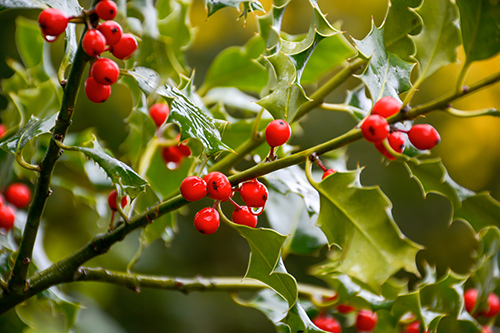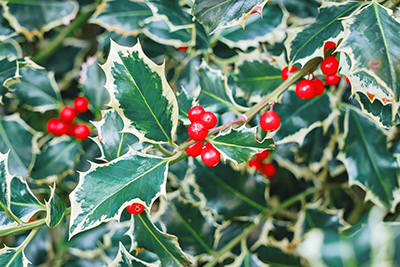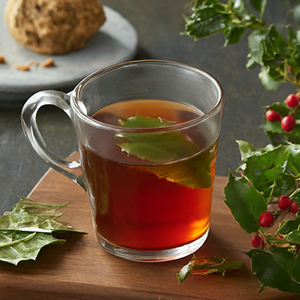Contents
Winter would not be the same season without mountain holly and its bright red berries. Capercaillies, those big wild cocks of northern forests in Spain and Europe, blackbirds, and many other forest animals, count on these berries for their winter food. Therefore, the habit of using this plant as a Christmas decoration should disappear. The massive gatherings in December endanger the food source of many animals, for which mountain holly is the only food during winter. In fact, in many European countries, this shrub is legally protected.

Mountain Holly Scientific Facts
- Scientific name: Ilex aquifolium L.
- Other names: Holly.
- French: Houx.
- Spanish: Acebo.
- Environment: Common in forests of chestnut and beech trees throughout Europe, though it also grows in mountainous, cold regions of North and South America. It is cultivated as an ornamental plant.
- Description: This shrub of the Aquifoliaceae family grows from 1 to 5 m high and has evergreen, stiff, spiny leaves of dark green. Its tiny flowers, which grow in the axiles of the leaves, are white or pink. The fruits are red berries that last the whole winter season.
- Parts of the plant used medicinally: The leaves.
Mountain Holly Healing Properties
The leaves of mountain holly contain ileicine, theobromine (a similar substance to caffeine, which is also found in cocoa), dextrose, ursolic and ilexic acids, rhutine, resins, and mineral salts (especially potassium and magnesium salts). Mountain holly leaves have the following properties, which are mainly caused by ileicine and theobromine:
- Antirheumatic – Because of its depurative effects, Mountain Holly is recommended for people suffering from arthritis and rheumatism to cleanse the blood from metabolic acid waste.
- Sudorific and febrifuge – Mountain holly leaves decrease fever, especially when treating influenza, colds, or bronchitis.
- Laxative and diuretic – They have depurative properties on the body since they simulate all its elimination functions.
- Heart-invigorating and stimulant because of their content of theobromine, whose effects are similar to caffeine’s.
Though without a scientific basis, the BARK of Mountain Holly has been used to prevent epileptic attacks. As a rule, mountain holly is seldom used as a medicinal plant since it demands a careful dosage, and even so, it can provoke nausea and gastric intolerance.
Warning

Mountain holly fruit, the red berries, are very poisonous. They produce intense nausea, vomiting, and diarrhea and can even cause death in large doses. Children are especially at risk of poisoning with these berries, which are a good meal for wild animals.
Appalachian Tea
There are similar species to mountain holly growing in America. Their appearance and active components are identical; thus, their medicinal properties are usually equal. Some of these species are, for instance, the Appalachian tea (Ilex cassine L.), which grows in the United States and Mexico.

Among others, there are also the oil weed or oil wood (Ilex theezans Mart.), which grows in Brazil and Paraguay, the yaupon (Ilex vomitoria Ait.); which grows in Mexico and the West Indies, and the Brazilian tree known as cauna (Ilex pseudobuxus Reiss.).
Another shrub growing in America is fever bush (Ilex veticillata [L.] Gray. = Prinos verticillatus L.) Due to its importance and unique features, the plant most widely known as belonging to the Ilex genus is the yerba mate (Ilex paraguayensis St. Hill).
How to use Mountain Holly
- Decoction or infusion with 40 to 60 grams of leaves per liter of water. Drink up to three cups daily, sweetened with honey.
DISCLAIMER: All content on this website is presented solely for educational and informational objectives. Do not rely on the information provided as a replacement for advice, diagnosis, or treatment from a qualified medical expert. If you are pregnant, nursing, or have any preexisting medical concerns, talk to your doctor before using any herbal or natural medicines.
REFERENCES
- George D. Pamplona-Roger, M.D. “Encyclopedia of Medicinal Plants.” George D. Pamplona-Roger, M.D. Encyclopedia of Medicinal Plants. Ed. Francesc X. Gelabert. vols. 2 San Fernando de Henares: Editorial Safeliz, 2000. 672, 673. Print.
- http://www.naturalmedicinalherbs.net/herbs/n/nemopanthus-mucronatus=mountain-holly.php
